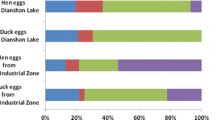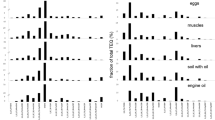Abstract
An increasing amount of evidence suggests that phthalic acid esters (PAE), polychlorinated biphenyls (PCB), polybrominated diphenyl ethers (PBDE), and organochlorine pesticides (OCP) are related to mutagenic, carcinogenic, and endocrine disruptor effects (EDCs). These lipophilic compounds are highly resistant to breakdown processes, and consequently remain in the environment, followed by uptake into the food chain. Human exposure to lipophilic compounds results from the consumption of food containing EDCs, mainly foodstuffs of animal origin with a high fat content, since these contaminants accumulate in fatty tissues. Foodstuffs in which EDCs can accumulate include meat, fish, eggs, and milk. We investigated the contamination in edible eggs to determine whether relative differences in the contaminants’ residue levels appeared in three types of egg production (i.e., battery, free-range, and organic). The results showed that PAEs, especially dimethyl phthalate contamination, was the most abundant in the battery eggs, and the PCBs, PBDEs, and OCPs were the most abundant in the free-range eggs. The eggs were contaminated by more than one chemical, and as many as five contaminants (PCB180, PBDE47, dimethyl phthalate, diethyl phthalate, and di-n-butyl phthalate in battery eggs, and PCB138, PCB153, PCB180, diethyl phthalate, and di-2-ethylhexyl phthalate in organic eggs) were detected in the same egg. However, none of the chemicals detected were at the maximum limit of acceptable risk.
Similar content being viewed by others
References
Abdelfatah EN, Abu-Zeid EH (2016) Assessment of pesticide residues in edible and unhatched chicken eggs in Sharkia Province, Egypt. Adv Anim Vet Sci 4:25–34
Ahmad R, Salem NM, Estaitieh H (2010) Occurrence of organochlorine pesticide residues in eggs, chicken and meat in Jordan. Chemosphere 78:667–671
Bauer E, Guo Z, Ueng Y-F, Bell LC, Zeldin D, Guengerich FP (1995) Oxidation of benzo(a)pyrene by recombinant human cytochrome P450 enzymes. Chem Res Toxicol 8:136–142
Cheng Z, Li H-H, Wang H-S, Zhu X-M, Sthiannopkao S, Kim K-W, Mohamed Yasin MS, Hashim JH, Wong M-H (2016) Dietary exposure and human risk assessment of phthalate esters based on total diet study in Cambodia. Environ Res 150:423–430
Cao XL (2010) Phthalate esters in foods: sources, occurrence, and analytical methods. Comp Rev Food Sci Food Saf 9:21–43
Darnerud PO, Atuma S, Aune M, Bjerselius R, Glynn A, Grawe KP (2006) Dietary intake estimations of organohalogen contaminants (dioxins, PCB, PBDE and chlorinated pesticides, e.g. DDT) based on Swedish market basket data. Food Chem Toxicol 44:1597–1606
Durmaz E, Ozmert EN, Erkekoglu P, Giray B, Derman O, Hincal F, Yurdakök K (2010) Plasma phthalate levels in pubertal gynecomastia. Pediatrics 125:122–129
EFSA (2005a) Opinion of the scientific panel on food additives, flavourings, processing aids and material in contact with food (AFC) on a request from the commission related to dibutylphthalate (DBP) for use in food contact materials: question no. EFSA-Q-2003-192. EFSA J 242:1–2
EFSA (2005b) Opinion of the scientific panel on food additives, flavourings, processing aids and materials in contact with food (AFC) on a request from the commission related to bis(2- ethylhexyl)phthalate (DEHP) for use in food contact materials: question no. EFSA-Q-2003-191. EFSA J 243:1–2
EFSA (2012) Update of the monitoring of levels of dioxins and PCBs in food and feed. EFSA J 10(7):2832. https://doi.org/10.2903/j.efsa.2012.2832
Fierens T, Servaes K, Van Holderbeke M, Geerts L, De Henauw S, Sioen I, Vanermen G (2012) Analysis of phthalates in food products and packaging materials sold on the Belgian market. Food Chem Toxicol 50:2575–2583
Fontcuberta M, Arques JF, Villalbi JR, Martinez M, Centrich F, Serrahima E, Pineda L, Duran J, Casas C (2008) Chlorinated organic pesticides in marketed food: Barcelona. Sci Total Environ 389:52–57
Fournier A, Feidt C, Travel A, Bizec BL, Venisseau A, Marchand P, Jondreville C (2012) Relative bioavailability to laying hens of indicator polychlorobiphenyls present in soil. Chemosphere 88:300–306
Fries GF, Marrow GS, Somich CJ (1989) Oral bioavailability of aged polychlorinated biphenyl residues contained in soil. Bull Environ Contam Toxicol 43:683–690
Gurel Y, Akkaya R, Yiğit Y, Koç F, Daş YK, Başsatan-Yorulmaz A, Kahveci I (2008) The investigation of organochlorinated pesticides and polychlorinated biphenyls residue levels in eggs of hens in Turkey. Etlik Vet Mikrobiyol Derg 19:13–18
Hallikainen A, Vartiainen T (1997) Food control surveys of polychlorinated dibenzo-p-dioxins and dibenzofurans and intake estimates. Food Addit Contam 14:355–366
Huwe JK, West M (2011) Polybrominated diphenyl ethers in U.S. meat and poultry from two statistically designed surveys showing trends and levels from 2002 to 2008. J Agric Food Chem 59:5428–5434
Ishida M, Suyama K, Adachi S (1981) Occurrence of dibutyl and di (2-ethylhexyl) phthalate in chicken eggs. J Agric Food Chem 29:72–74
Jarasova A (2006) Phthalic acid esters (PAEs) in the food chain. Czech J Food Sci 24:223–231
Jarosova A, Harazim J, Kratka L, Kolencikova D (2010) Screening of phthalic acid esters in raw materials, premixes and feed additives. Environ Chem Lett 8:387–391
Kuzukiran O, Yurdakok-Dikmen B, Totan FE, Celik C, Orhan EC, Bilir EK, Kara E, Filazi A (2016) Analytical method development and validation for some persistent organic pollutants in water and sediments by gas chromatography mass spectrometry. Int J Environ Res 10:401–410
Lambiase S, Serpe FP, Cavallo S, Rosato G, Baldi L, Neri B, Esposito M (2017) Occurrence of polychlorinated dibenzo-p-dioxins (PCDDs), dibenzofurans (PCDFs) and polychlorinated biphenyls (PCBs) in eggs from free-range hens in Campania (southern Italy) and risk evaluation. Food Addit Contam Part A: Chem Anal Control Expo Risk Assess 34:56–64
Lorber M (2008) Exposure of Americans to polybrominated diphenyl ethers. J Expo Anal Environ Epidemiol 18:2–19
Luzardo OP, Rodríguez-Hernández Á, Quesada-Tacoronte Y, Ruiz-Suárez N, Almeida-González M, Henríquez-Hernández LA, Zumbado M, Boada LD (2013) Influence of the method of production of eggs on the daily intake of polycyclic aromatic hydrocarbons and organochlorine contaminants: an independent study in the Canary Islands (Spain). Food Chem Toxicol 60:455–462
Magnusson B, Ornemark U (2014). Eurachem guide: the fitness for purpose of analyticalmethods—a laboratory guide to method validation and related topics, (2nd ed. 2014). ISBN 978–91–87461-59-0. Available from www.eurachem.org Accessed 23 April 2018
Olanca B, Cakirogullari GC, Ucar Y, Kirisik D, Kilic D (2014) Polychlorinated dioxins, furans (PCDD/Fs), dioxin-like polychlorinated biphenyls (dl-PCBs) and indicator PCBs (ind-PCBs) in egg and egg products in Turkey. Chemosphere 94:13–19
Porta M, Zumeta E (2002) Implementing the Stockholm treaty on persistent organic pollutants. Occup Environ Med 59:651–652
Ramesh A, Walker SA, Hood DB, Guillen MD, Schneider K, Weyand EH (2004) Bioavailability and risk assessment of orally ingested polycyclic aromatic hydrocarbons. Int J Toxicol 23:301–333
Rawn DF, Sadler AR, Quade SC, Sun WF, Kosarac I, Hayward S (2012) The impact of production type and region on polychlorinated biphenyl (PCB), polychlorinated dibenzo-p-dioxin and dibenzofuran (PCDD/F) concentrations in Canadian chicken egg yolks. Chemosphere 89:929–935
Rhind SM (2002) Endocrine disrupting compounds and farm animals: their properties, actions and routes of exposure. Domest Anim Endocrinol 23:179–187
Rodríguez-Hernández A, Camacho M, Boada LD, Ruiz-Suarez N, Almeida-González M, Henríquez-Hernández LA, Zumbado M, Luzardo OP (2015) Daily intake of anthropogenic pollutants through yogurt consumption in the Spanish population. J Appl Anim Res 43:373–383
Rostami I, Juhasz AL (2011) Assessment of persistent organic pollutant (POP) bioavailability and bioaccessibility for human health exposure assessment: a critical review. Crit Rev Environ Sci Technol 41:623–656
Sireli UT, Filazi A, Yurdakok-Dikmen B, Iplikcioglu-Cil G, Kuzukiran O, Orhan CE (2017) Determination of phthalate residues in different types of yogurt by gas chromatography-mass spectrometry and estimation of yogurt-related intake of phthalates. Food Anal Method 10:3052–3062
Stockholm Convention (2009) Guidance on feasible flame-retardant alternatives to commercial pentabromodiphenyl ether-2009. UNEP/POPS/COP4/INF24 Stockholm Convention on Persistent Organic Pollutants (POPs) Available from http://chmpopsint/Implementation/NIPs/Guidance/Guidance fortheinventoryof PBDEs/tabid/3171/Defaultaspx, Access: 18 September 2018
Suyama K, Nakamura H, Ishida M, Adachi S (1977) Lipids in the exterior structures of the hen egg. J Agric Food Chem 25:799–803
Tao S, Liu WX, Li XQ, Zhou DX, Li X, Yang YF, Yue DP, Coveney RM (2009) Organochlorine pesticide residuals in chickens and eggs at a poultry farm in Beijing, China. Environ Pollut 157:497–502
The Ministry of Health (2014) Turkey nutrition and health survey-2010. Habits and nutritional status assessment final report. General directorate for health research, Hacettepe University Nutrition and Dietetics department, Ankara Numune and Research Hospital Joint Research. Publication No: 931, Ankara. [Turkish]. Available from http://www.sagem.gov.tr/TBSA_Beslenme_Yayini.pdf. Accessed 23 April 2018
Thompson LA, Ikenaka Y, Yohannes YB, van Vuren JJ, Wepener V, Smit NJ, Darwish WS, Nakayama SMM, Mizukawa H, Ishizuka M (2017) Concentrations and human health risk assessment of DDT and its metabolites in free-range and commercial chicken products from KwaZulu-Natal, South Africa. Food Addit Contam Part A 34:1959–1969
Tullo A (2003) Great Lakes to phase out flame retardants. Chem Eng News 81:13
US EPA (2009) DecaBDE phase-out initiative. 2009. Existing Chemicals OPPT [Internet]. United States Environmental Protection Agency; https://hero.epa.gov/hero/index.cfm/reference/download/reference_id/1003362. Accessed 23 April 2018
Van Overmeire I, Pussemier L, Hanot V, de Temmerman L, Hoenig M, Goeyens L (2006) Chemical contamination of free-range eggs from Belgium. Food Addit Contam 23:1109–1122
Van Overmeire I, Pussemier L, Waegeneers N, Hanot V, Windal I, Boxus L, Covaci A, Eppe G, Scippo ML, Sioen I, Bilau M, Gellynck X, Steur H, De Tangni EK, Goeyens L (2009) Assessment of the chemical contamination in home-produced eggs in Belgium: general overview of the CONTEGG study. Sci Total Environ 407:4403–4410
Windal I, Hanot V, Marchi J, Huysmans G, Van Overmeire I, Waegeneers N, Goeyens L (2009) PCB and organochlorine pesticides in home-produced eggs in Belgium. Sci Total Environ 407:4430–4437
Wormuth M, Scheringer M, Vollenweider M, Hungerbühler K (2006) What are the sources of exposure to eight frequently used phthalic acid esters in Europeans? Risk Anal 26:803–824
Xu M, Qiu Y, Bignert A, Zhou Y, Zhu Z, Zhao J (2015) Organochlorines in free-range hen and duck eggs from Shanghai: occurrence and risk assessment. Environ Sci Pollut Res Int 22:1742–1749
Yurdakok-Dikmen B, Alpay M, Kismali G, Filazi A, Kuzukiran O, Sireli UT (2015) In vitro effects of phthalate mixtures on colorectal adenocarcinoma cell lines. J Environ Pathol Toxicol Oncol 34:115–123
Author information
Authors and Affiliations
Corresponding author
Ethics declarations
Conflict of interest
The authors declare that they have no conflict of interest.
Ethical approval
This article does not contain any studies with human participants or animals performed by any of the authors.
Informed consent
Not applicable.
Additional information
Responsible editor: Philippe Garrigues
Rights and permissions
About this article
Cite this article
Kuzukiran, O., Yurdakok-Dikmen, B., Sevin, S. et al. Determination of selected endocrine disruptors in organic, free-range, and battery-produced hen eggs and risk assessment. Environ Sci Pollut Res 25, 35376–35386 (2018). https://doi.org/10.1007/s11356-018-3400-5
Received:
Accepted:
Published:
Issue Date:
DOI: https://doi.org/10.1007/s11356-018-3400-5




